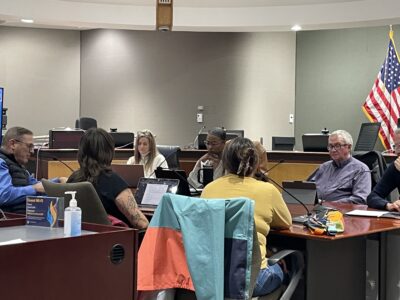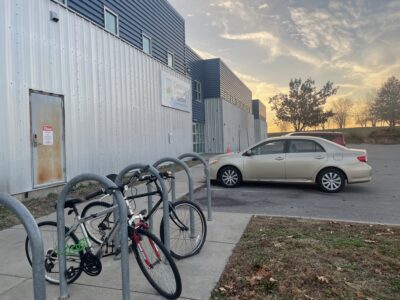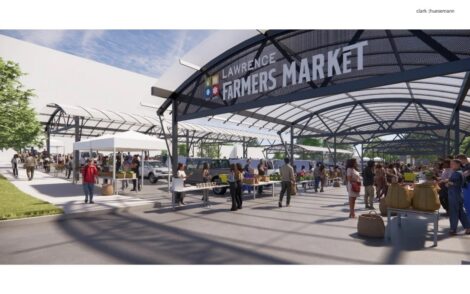With Lawrence facing $6.5 million in budget cuts, City Manager, finance team discuss how to slice ‘a smaller pie’

photo by: Chad Lawhorn/Journal-World
Lawrence City Hall is pictured on Oct. 11, 2024.
The City of Lawrence knew it would have to alter its budget process after last year.
The budget that City Commissioners eventually passed for 2025 was considered “unsustainable” by city staff and commissioners, and the city began working to craft its budget in January, as the Journal-World reported.
The budget proposal that was introduced to the City Commission Tuesday contained a flat mill levy, $6.4 million in cuts to a variety of departments and the addition of $2 million to the city’s reserve fund. City Manager Craig Owens noted the gap the city found itself in after 2025 would be challenging to correct, but the proposal in front of commissioners is a “healthy reality to achieve a sustainable budget,” as he said during that Tuesday meeting.
The Journal-World spoke with Owens, Alley Porter, a budget manager with the city finance department and Rachelle Mathews, the city’s Director of Finance, Wednesday to provide a more in-depth look at some of the key talking points of the 2026 budget proposal.
Early work to thank for no anticipated layoffs
When Owens spoke to City Commissioners in January, he noted the $6.5 million projected budget shortfall at the time would be, on average, the compensation of 50 city employees.
Owens told the Journal-World he had been through periods of municipal cuts during his career and knew the best way the city could go throughout the budget process was to avoid layoffs, which would harm not just the staff morale but not let the city “adapt its service levels” with the loss of employees.
Despite the proposal’s cuts, all the reductions in staffing across these departments only affect vacant positions. Owens credited the early work on the budget on a big reason how the proposal led to no layoffs.
“Having the advantage of time gave us the space to do this,” Owens said.
Porter said the current budget proposal includes just 24 fewer positions compared to last year’s budget. Along with the earlier discussions providing a better insight of where cuts might be, it also helped with the implementation of a voluntary early retirement program. The city began offering voluntary early retirement packages — it also created an internal hiring process with the goal to limit vacancies — in April, and in May, 20 employees accepted those offers, as the Journal-World reported. There will be another window for employees to take the early retirement offer starting in August.
Owens said the early work also gave employees time to be “thoughtful” about the early retirement plans, especially when some people had served in the city for decades.
“This is a big decision for employees,” Owens said. “We wanted to make sure we gave them time to think of it.”
Porter said many of the positions that will end up being vacant — through either early retirements or based on the current headcount — received higher pay or benefits than average, which is part of why the city could reduce fewer positions than initially anticipated.
Compromise key for LDCFM funding; future conversations with Douglas County loom
One of the most interesting parts of the 2026 budget proposal is regarding the Lawrence-Douglas County Fire Medical department.
In the current plans, the department will receive funding in the city’s Capital Improvement Plan for a new fire station, known as “Station 6,” in the northwestern portion of the city. The city would allocate about $1.5 million for the project in 2026, then about $5.4 million and $5.7 million in 2027 and 2028, respectively. However, the budget as it stands would cut $1.5 million in funding for LDCFM which would remove one fire engine out of the fleet, reducing the department’s daily minimum staffing from 39 people to 36 people.
Owens said LDCFM included a large group of members across the department in its budget discussions to land on the current proposal, which LDCFM Interim Chief Joe Hardy noted had “the least impact” on service levels while maintaining four-person staffing per vehicle — a key priority for many firefighters.
Owens said the proposal was “all compromise” but the plan will fit at the time, especially with the long-time need for expanding LDCFM’s footprint. Incident calls have increased year over year since 2020, and multiple commenters on Tuesday spoke about how the need for a new station has been known by the city “for quite a while,” Owens said. The issue has been that the city has limited options on how to fund the construction.
“We know the cost pretty well, what we haven’t known is how we’re going to pay for those,” Owens said.
Cuts could have been even steeper for LDCFM if not for funding Douglas County is considering giving. The County Commission is considering an option to add about $183,000 extra in county funding that would limit cuts to positions from 20 to 10, as the Journal-World reported.
Although the city added funding for completing the physical station, Owens noted there will need to be future discussions with Douglas County about how to ensure the station is fully staffed. The City of Lawrence funds about 64% of LDCFM’s costs while the county funds the remaining 36%. That can complicate the question of what exactly the funding methods will look like, and Owens said he anticipates “broad conversations” with the county on ensuring the funding is there for expansion.
“I know that’s their expectation as well and look forward to those conversations over the next few months,” Owens said.
Parks, Recreation and Culture to be determined with membership fee proposal
One department that still needs to iron out some details for its 2026 budget is the Parks, Recreation and Culture department.
Next week, the PRC will present a membership fee proposal for its recreation centers to its advisory board and the City Commission. As the Journal-World reported, it includes monthly membership fees that can cost up to $25 for adult residents along with cheaper options for seniors, youth and lower income residents.
Porter said the current proposal includes the forecast of increased revenues from the membership fees. Porter said the department’s current budget, which includes eliminating three full-time and multiple part-time positions and reductions in hours and services at the city’s rec centers, factors in increased revenue of just over $1.1 million from the new membership program, tournament spectator fees at Sports Pavilion Lawrence and other fee increases to programming.
According to a city presentation, if the membership fee proposal is not included in next year’s budget, the PRC will need to cut just over $1.4 million from its budget. That will mean eliminating six full-time positions, reduced hours and services at recreation facilities, potential removal of park amenities like play structures or shelters and fewer sports program offerings.
The membership fee proposal will be discussed by the Parks and Recreation Advisory Board Monday night and by the City Commission on Tuesday, July 15.
City debt to fall off in CIP; discussions to be had on Lawrence Loop projects
In recent years, Lawrence commuters could see some of the evidence of long-term infrastructure projects by gazing at the orange cones around some of the city’s key arterial streets.
Many of those significant projects, like the Sixth Street reconstruction, had funding saved in past years by the city’s Capital Improvement Plan, a blueprint to tackling infrastructure projects that exceed $100,000. The CIP for the 2026 budget, which plans out funding for five years, would be $386 million, with roughly $157 million of projects anticipated to occur in 2026.
Much that outlay in 2026 — $40.2 million to be exact — comes from the $130 million public works campus, with the first phase expected to be completed in 2026 and the final phase finished in 2027 as the Journal-World reported.
But once 2027 rolls around, the debt costs are much lower. Mathews said in prior years, the city made a “conscious investment” to make key infrastructure upgrades with the goal to achieve the lowest cost of ownership. Once those were finished, she said the CIP would have less major projects to get back into an affordable place for the debt service fund.
“(The CIP) was planned to frontload some things to get some big projects done and go back down,” Mathews said.
Owens said the city realized some of the infrastructure had “long term neglect,” and it needed to make some investments “to catch up.” Owens noted the new MSO campus is replacing something that was 80 years old and built for a much smaller community. The new facility is something that is a “multigenerational investment” in his eyes.
“That’s a big investment we knew was going to be a lump but we would benefit for generations to come,” Owens said.
City Commissioners also asked for the city staff to look into providing options on how to potentially add CIP funding for unfinished projects for the Lawrence Loop, a planned network of 22 miles of paved walking and biking paths around the city. Nearly 100 residents wrote in to urge the city to fund three projects that would complete the loop.
Owens said one issue the city is facing is one of the projects — the section between Michigan Street and Sandra Shaw Park — has been unable to acquire property required to complete the project. Although the project received a grant from KDOT, Owens said it currently “doesn’t look like it will be possible” as the grant funding was contingent specifically for the proposed route of that segment.
Owens said the city will likely be still be reliant on “opportunistic events” like grants or other development that opens up a segment of a trail which completed many of the other sections of the Loop. Some of the options the city will present on funding the Loop would be identifying the lowest priority street project or spending more money, which would require increased taxes.
Owens said he understands the Lawrence community has been used to coming together to urge the commission to consider or reject certain projects of interest, but often without saying what they would “move around in the budget” to get that done. Since the commission has to consider the whole picture, he hopes that the community can provide those solutions as well especially in a time of financial crunch.
“They are trying the best they can on figuring out how to slice a smaller pie,” Owens said.







